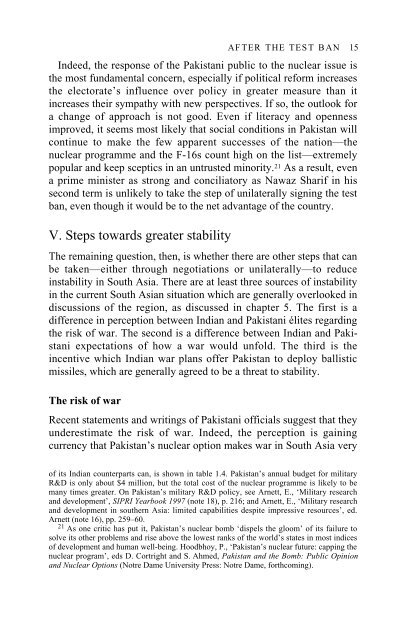Nuclear Weapons and Arms Control in South Asia after the Test Ban
Nuclear Weapons and Arms Control in South Asia after the Test Ban
Nuclear Weapons and Arms Control in South Asia after the Test Ban
You also want an ePaper? Increase the reach of your titles
YUMPU automatically turns print PDFs into web optimized ePapers that Google loves.
AFTER THE TEST BAN 15<br />
Indeed, <strong>the</strong> response of <strong>the</strong> Pakistani public to <strong>the</strong> nuclear issue is<br />
<strong>the</strong> most fundamental concern, especially if political reform <strong>in</strong>creases<br />
<strong>the</strong> electorate’s <strong>in</strong>fluence over policy <strong>in</strong> greater measure than it<br />
<strong>in</strong>creases <strong>the</strong>ir sympathy with new perspectives. If so, <strong>the</strong> outlook for<br />
a change of approach is not good. Even if literacy <strong>and</strong> openness<br />
improved, it seems most likely that social conditions <strong>in</strong> Pakistan will<br />
cont<strong>in</strong>ue to make <strong>the</strong> few apparent successes of <strong>the</strong> nation—<strong>the</strong><br />
nuclear programme <strong>and</strong> <strong>the</strong> F-16s count high on <strong>the</strong> list—extremely<br />
popular <strong>and</strong> keep sceptics <strong>in</strong> an untrusted m<strong>in</strong>ority. 21 As a result, even<br />
a prime m<strong>in</strong>ister as strong <strong>and</strong> conciliatory as Nawaz Sharif <strong>in</strong> his<br />
second term is unlikely to take <strong>the</strong> step of unilaterally sign<strong>in</strong>g <strong>the</strong> test<br />
ban, even though it would be to <strong>the</strong> net advantage of <strong>the</strong> country.<br />
V. Steps towards greater stability<br />
The rema<strong>in</strong><strong>in</strong>g question, <strong>the</strong>n, is whe<strong>the</strong>r <strong>the</strong>re are o<strong>the</strong>r steps that can<br />
be taken—ei<strong>the</strong>r through negotiations or unilaterally—to reduce<br />
<strong>in</strong>stability <strong>in</strong> <strong>South</strong> <strong>Asia</strong>. There are at least three sources of <strong>in</strong>stability<br />
<strong>in</strong> <strong>the</strong> current <strong>South</strong> <strong>Asia</strong>n situation which are generally overlooked <strong>in</strong><br />
discussions of <strong>the</strong> region, as discussed <strong>in</strong> chapter 5. The first is a<br />
difference <strong>in</strong> perception between Indian <strong>and</strong> Pakistani élites regard<strong>in</strong>g<br />
<strong>the</strong> risk of war. The second is a difference between Indian <strong>and</strong> Pakistani<br />
expectations of how a war would unfold. The third is <strong>the</strong><br />
<strong>in</strong>centive which Indian war plans offer Pakistan to deploy ballistic<br />
missiles, which are generally agreed to be a threat to stability.<br />
The risk of war<br />
Recent statements <strong>and</strong> writ<strong>in</strong>gs of Pakistani officials suggest that <strong>the</strong>y<br />
underestimate <strong>the</strong> risk of war. Indeed, <strong>the</strong> perception is ga<strong>in</strong><strong>in</strong>g<br />
currency that Pakistan’s nuclear option makes war <strong>in</strong> <strong>South</strong> <strong>Asia</strong> very<br />
of its Indian counterparts can, is shown <strong>in</strong> table 1.4. Pakistan’s annual budget for military<br />
R&D is only about $4 million, but <strong>the</strong> total cost of <strong>the</strong> nuclear programme is likely to be<br />
many times greater. On Pakistan’s military R&D policy, see Arnett, E., ‘Military research<br />
<strong>and</strong> development’, SIPRI Yearbook 1997 (note 18), p. 216; <strong>and</strong> Arnett, E., ‘Military research<br />
<strong>and</strong> development <strong>in</strong> sou<strong>the</strong>rn <strong>Asia</strong>: limited capabilities despite impressive resources’, ed.<br />
Arnett (note 16), pp. 259–60.<br />
21 As one critic has put it, Pakistan’s nuclear bomb ‘dispels <strong>the</strong> gloom’ of its failure to<br />
solve its o<strong>the</strong>r problems <strong>and</strong> rise above <strong>the</strong> lowest ranks of <strong>the</strong> world’s states <strong>in</strong> most <strong>in</strong>dices<br />
of development <strong>and</strong> human well-be<strong>in</strong>g. Hoodbhoy, P., ‘Pakistan’s nuclear future: capp<strong>in</strong>g <strong>the</strong><br />
nuclear program’, eds D. Cortright <strong>and</strong> S. Ahmed, Pakistan <strong>and</strong> <strong>the</strong> Bomb: Public Op<strong>in</strong>ion<br />
<strong>and</strong> <strong>Nuclear</strong> Options (Notre Dame University Press: Notre Dame, forthcom<strong>in</strong>g).

















